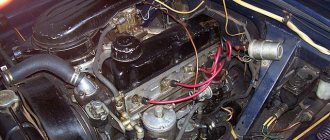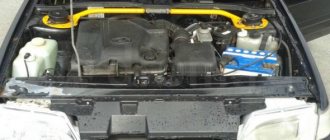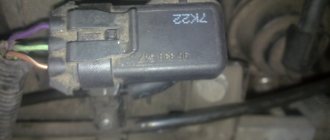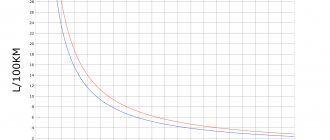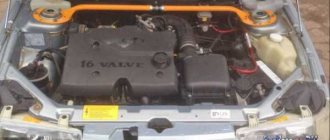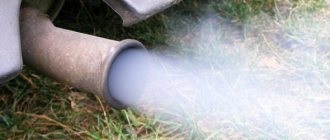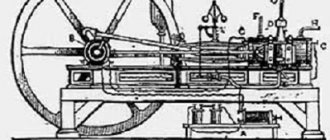With high fuel prices, many drivers are starting to forgo the preheating features included in their cars. Now almost every modern alarm system has the ability to start the engine remotely from a button in order to warm it up, which is especially important in the winter. Many drivers believe that such warm-up while idling wastes a lot of fuel. But this is not entirely true, and in this article we propose to consider the question of how much gasoline or diesel a car consumes when idling.
What is remote car engine starting?
Depending on the alarm system installed on the car, the range of available functions and their flexibility varies. If the alarm system has a remote engine start function, most likely it has several modes of operation of this functionality:
Push button start;
- Start at a specific time (this is useful if you go to work at the same time every day);
- Start after a certain time. For example, starting the engine every 3 hours;
- Start when engine temperature drops. That is, the engine will start, warm up, cool down, and then start again. This allows you to always keep the engine at the optimal temperature for driving.
Depending on which remote engine warm-up option is used, the amount of fuel consumed will vary greatly.
What factors affect fuel consumption at idle?
Fuel consumption at idle is determined by several factors; let’s look at the main ones:
In addition to these factors, fuel consumption will be influenced by less significant parameters, such as the number of active electronic consumers, engine oil thickness, and engine condition.
How to save money?
Everything is very simple, you just need to follow these simple rules.
- You should not warm up the engine for too long, this leads to an increase in consumption both per hour and in general. It has been proven that warming up while driving is more effective than warming up while standing.
- Do not start the engine unless absolutely necessary. If you want to stay warm in the car and you are forced to start the engine, think about whether there is an alternative option, perhaps there is a secluded cafe nearby where you could wait out the necessary time.
- Monitor the condition of your car. Everything is simple here, the serviceability of the engine allows you not only to save fuel, but also allows you to avoid more expensive repairs.
- Do not turn on the energy consumers listed above unless absolutely necessary. Anything that can load the generator increases resistance, the engine turns more difficult, and therefore fuel consumption per hour at idle increases.
- Refuel only with high-quality fuel. The price of such fuel may be higher, but due to better quality and a higher octane number, you will be able to reduce consumption and save on repairing fuel equipment. In the long run, by purchasing more expensive fuel, you can realize real savings.
What is your fuel consumption at idle? Tell us about your observations and ways to save fuel! That’s all for me, see you again on Question Auto, I hope you liked the article and found it interesting!?
How much gasoline or diesel is consumed at idle speed?
Depending on the engine and other conditions, the numbers will vary slightly; here are the average values.
At idle speed when the engines are warm, cars consume:
- With a volume of 1.4 liters - about 0.6 liters per hour;
- With a volume of 1.6 liters - about 0.8 liters per hour;
- With a volume of 2 liters - about 1 liter per hour.
At idle speed at an ambient temperature of -10 degrees Celsius, an unheated engine consumes:
- With a volume of 1.4 liters - about 0.8 liters per hour;
- With a volume of 1.6 liters - about 1 liter per hour;
- With a volume of 2 liters - about 1.2 liters per hour.
At the same time, increased consumption occurs in the first 10 minutes of engine operation, until the oil reaches the optimal operating temperature. After this, fuel consumption drops.
Accordingly, if you use autostart, then each start of a cold engine at a temperature of -10 degrees Celsius for a 10-minute warm-up will cost 100-200 ml of fuel.
Important: At lower temperatures, the indicator changes because the engine takes longer to warm up.
Drivers are often interested in the consumption of gasoline and diesel at idle speed per hour. After all, quite often you have to keep a running car in this mode. In winter, this is a warm-up before the trip. Also, do not forget about stopping at traffic lights and in traffic jams. All this makes you think about how economical your car’s engine is when idling. Moreover, this question is asked by owners of any car models, regardless of the fuel consumption declared by the manufacturer. Knowing the average consumption will allow you to more accurately calculate the amount of fuel when refueling.
What is the consumption of gasoline and diesel at idle speed per hour depends on several factors. It is important to take into account the type of fuel, the features of a particular engine, and the serviceability of all elements of the power unit. Only taking into account all these nuances will allow you to approximately calculate fuel consumption.
How to correctly calculate fuel consumption? Manufacturers claim that fuel consumption is equal to consumption per 10 km of travel in urban driving mode.
So how much does autostart consume?
Why does a gazelle stall at idle
? It’s not difficult to calculate. We will take the standard case of “10” minutes before work, and “10” after the working day (why “10”, because rarely will anyone change the standard alarm settings for 5 minutes or less).
I will also take the flow rate at -10 degrees. Let me remind you that for the first 3 minutes it is 1 l/h
At -20 deg. 5 minutes. – 1l/h
At -30 deg. 7 min. – 1l/h
It turns out (3+3=6min.)-1l/h, then (7+7=14min.)-0.7l/h
We have 60 minutes in an hour:
Then – 1000ml/60 = 16.6ml/min *6 = 100ml
Next – 700ml/60 = 11.7ml/min *14 = 163ml
As a result, at -10 degrees. Celsius (2.0 liter engine) - for two starts of 10 minutes each, consumes - 100 + 163 ml = 263 ml. OR ALMOST - 0.3 liters. It's up to you to decide whether it's a lot or a little.
Of course, a car with a smaller engine will spend a little less at idle. If we go the logical route, then let’s say the 1.6 liter engine is 20% smaller in volume than the 2.0 version. This means that it will consume 20% less at idle.
263ml – 20% = 210 ml.
Of course, if your engine volume is larger and the temperature is lower, then everything can be calculated for your conditions. As you can see, all this is quite simple.
Well, before concluding the article, I would like to say that fuel consumption in winter is affected not only by idling (of the engine), but also by a bunch of other parameters. For example, winter tires, oil thickness, snow on the roads, etc. Watch all about this in my video, I recommend it to everyone.
This is where I end, I think my article and video were useful to you. Sincerely yours, AUTOBLOGGER
What affects idle speed?
As a rule, fuel consumption is not a constant indicator. Often the result can differ significantly from the optimal one. Let's see when the flow increases:
- Machine malfunction
. With many problems with the power supply system, ignition, engine, idle consumption increases. Therefore, always monitor the technical condition of your car. Always diagnose and fix problems in a timely manner; - Season
. At low air temperatures, the engine consumes more fuel immediately after starting. As a result, in winter, operating for a long time at idle speed, it burns more fuel compared to summer. Take this factor into account; - Low quality fuel
. If the octane number does not correspond to the required one, then most likely when idling (and not only) the fuel will simply fly out into the pipe; - Connected additional equipment
. If there is an air conditioner on, or a powerful stereo system, then fuel consumption can be increased by 15-25%.
How to reduce fuel consumption
All drivers want to spend fuel as economically as possible. To reduce the level of gasoline losses when idling, experienced car enthusiasts recommend:
- warm up the engine only until the warm-up speed drops, i.e. 5 minutes;
- do not turn on additional devices, such as headlights, and reduce the load on heating the interior as much as possible;
- Warm up windows and mirrors if this is absolutely necessary;
- insulate the engine and install an autonomous heating system - as a result, the likelihood of engine freezing will be reduced to a minimum.
When the engine speed drops, you need to start driving and complete the warm-up while on the road.
Myths about fuel consumption
There are a large number of myths circulating among car enthusiasts about car fuel consumption. Some of these legends are cultivated by car manufacturers. Below we will look at the most popular myths:
- Coasting reduces consumption
. This is only partly true. Indeed, with a sharp release of gas at a specific point in time, the fuel supply is reduced. This is done to stabilize engine operation. But, with constant idling, fuel consumption is not much less. At the same time, do not forget that in the future you will need to pick up speed, which decreases when coasting, this leads to an increase in fuel consumption. Accordingly, all savings are eliminated. The only option for using coasting is to pre-reduce speed when stopping or before turning; - In traffic jams you need to turn off the engine
. Supposedly this saves fuel. This myth appeared simultaneously with the start-stop function in modern cars. Manufacturers needed to sell this new product to drivers. In fact, it makes sense to turn off the car when parked for more than 10 minutes. If you turn off the engine every time you stop, the consumption will only increase. When starting the engine, some of the fuel simply flies out into the exhaust pipe without any effect. This also increases the wear rate of power unit parts. Therefore, do not turn off the car when stopping at a traffic light; - Installing a spoiler reduces consumption
. This statement is true exactly the opposite. In fact, the wing is designed to press the car to the road. This happens due to an increase in resistance to oncoming flow. Accordingly, the higher the angle of attack and downforce, the more fuel consumption increases. This myth comes from motorsport, where a wing really reduces fuel consumption, but there the spoiler or wing is selected individually, and the car is necessarily blown in a wind tunnel; - The higher the gear, the lower the consumption
. In fact, this is not entirely true. The optimal engine operating mode from the point of view of economy is 70-75% of maximum speed. For example, at a maximum speed of 4000, the most economical will be to maintain 3000-3100 rpm. In a high gear, the engine runs at lower speeds and consumption increases.
Formula for calculating fuel costs
In order to determine the cost of purchasing diesel fuel, you must use a special formula:
- Qtotal = Stotal/100 x Qavg, where
- Qtot — fuel consumption on the road;
- Stotal - the distance that the vehicle must cover along the planned route;
- Qср – fuel consumption (in liters per 100 km).
Then the resulting figure must be multiplied by the average cost of diesel fuel and rounded to the nearest whole number.
Having found out the exact value of fuel consumption, you can calculate the cost of fuel per 1 km of road. To do this you need to use the formula:
(Qav*fuel cost)/100 = Fuel cost per 1 km, where Qav is fuel consumption (in liters per 100 km).
We decide on a time interval.
In fact, you can use either 1 hour or any other period of time in calculations, it’s just that an hour is more familiar to perception (km/h).
Nominal fuel consumption values for a stationary vehicle – do they exist?
For the most part, you are unlikely to find such information from the manufacturer. Yes, perhaps there will be figures for the model range as a whole, or for a series of engines, but they try to hush up specific indicators, primarily because the consumption figures are not so high, but some comfort elements of modern cars can significantly change them.
For example, the following factors affect gasoline consumption at idle:
- The season of the year, or rather the external temperature, because even with a stationary car you can use the air conditioner, and this is a very noticeable consumer.
In winter, the volume of fuel burned when warming up also depends on the ambient temperature, or more precisely on the engine temperature. At lower temperatures, modern on-board electronics make the air-fuel mixture richer and warm-up speeds higher, increasing consumption.
- All energy consumers of the vehicle.
When parked, the main load is taken on by the generator and air conditioner. So in the summer, with the headlights on, the air conditioning and the subwoofer screaming at the top of your lungs in the trunk, you will spend much more fuel in 60 minutes than in silence and darkness, with the windows open, enjoying the rustle of the engine, diluted with the chirping of crickets.
- The health of the engine or other vehicle systems is a self-evident factor that affects the vehicle’s performance, and not only at idle. A “healthy” car always eats less.
- Engine capacity.
About the alarm
Alarm system with auto start, allows you to start the car for 5 - 10 minutes. Moreover, usually the default is 10 minutes, but you can set it to 5, on some alarms it’s 3 minutes.
You can set it to run automatically by time, for example:
- Will start before you arrive
- Or by time interval (every 2 hours),
- By temperature (warmed up - stopped - cooled down - started again).
- Well, of course, you can start it yourself from the window in the morning (this is if the car is parked in front of the windows).
The most common are points 1 and 4, and basically no one removes the factory settings; the machine “keeps on” for 10 minutes. (it is during this time that we will calculate fuel consumption below)
How to measure the volume (per hour) of gasoline consumed at idle?
To do this, you just need to find out how much fuel will disappear from the tank over a certain period of time. It looks simple, but not quite. On average, a gasoline car consumes about 1 liter of fuel per hour, excluding the same air conditioner, some more, some less. However, how to find out your indicators.
If you are the owner of a classic VAZ , and even with a carburetor engine, you are lucky, in quotes, probably, in terms of the modernity of the car, but not with the calculations. It will be easiest for you to find out the treasured numbers:
- replace the fuel line going from the tank to the fuel pump with a piece of sludge lowered into a can of gasoline with a precisely known amount of fuel;
- give the pump a couple of pumps and start the car;
- let the machine hum for at least 30 minutes, and for the purity of the experiment - 60;
- measure how much fuel is left in the canister, subtract it from the original amount - this will be your consumption per hour, or in the period of time during which you conducted the experiment (the calculator will help bring the indicators to the usual ones).
In injection cars, this method cannot be repeated, since, most often, the fuel pump itself is located in the tank. Connecting the canister will only result in the car not even starting. The only simple way applicable to the mentioned cars is to fill the tank to full, let the car run for half an hour/hour and refuel again. How much the tank will hold after this idle operation is the desired indicator. Decide for yourself what to do with this information.
Opinion of car owners.
“I read somewhere that manufacturers say that the car’s appetite at idle per hour is equal to how much it needs to travel 10 km. I checked this statement on my Chevrolet AVEO, it’s true: in both cases the car consumed 0.8 liters of gasoline.”
“I once measured the consumption of XX on a Renault Duster and was unpleasantly surprised. The car eats about 1.5 liters. After that, I try to do everything possible to make the car buzz less often, and, of course, I only fill up at proven gas stations and don’t forget to carry out regular vehicle diagnostics. This doesn’t really reduce gasoline consumption, but it saves money.”
“I took measurements on my 2-liter Ford Focus. At idle it consumes 0.8-1 liter of fuel. Maybe this information will be useful to someone.”
“In my opinion, all these methods are a thing of the past! All modern cars have a fairly smart on-board computer that displays all the necessary information. Skoda Octavia shows a consumption of 0.9-1.1 l/h at idle.”
“I also decided to experiment. The Honda turned out to be more voracious than the Mitsubishi; the first spent 1.2-1.4 liters of fuel on the XX, while the second used only a liter.”
“I drive a Matiz, the on-board computer always shows different values, I assume this is due to the different quality of gasoline and the degree of engine heating, I can’t find any other reasons why it shows either 0.6, then 0.9, or even 1.3 liters "

